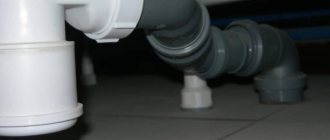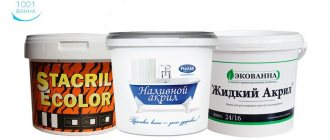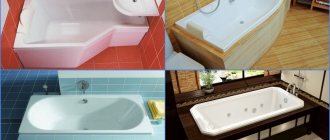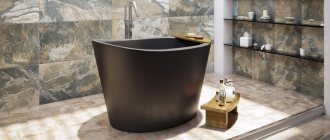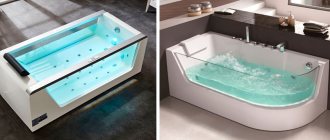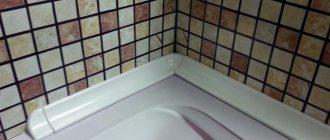Cast iron is the very first material from which bathtubs were made on an industrial scale.
Until now, they are popular among consumers due to their undeniable advantages .
What is the first association that comes to mind when you hear “cast iron bathtub”? That's right, it's very heavy. Heavy weight is a distinctive feature of products made from this material.
If you are planning to choose and buy a cast iron hot tub or, perhaps, on the contrary, get rid of it, would it be a good idea to know how much it weighs? We will talk about this in detail in the article.
Advantages and disadvantages of a cast iron bathtub
Plumbing manufacturers use new materials - acrylic, earthenware, marble, but cast iron continues to be in great demand; it is the leader in the plumbing market. Such baths, despite their conservative design, have many advantages.
Among them:
- Long service life. Cast iron products are 3-5 times superior to competitors in this parameter. Many apartments still have old bowls from Soviet times in good condition. Manufacturers claim a service life of 30 years, but according to statistics, such things last longer. There are restoration systems for cast iron bowls that extend their service life.
- Temperature preservation. Having heated up once, the bowl gives off heat for a long time, the water slowly cools down. In addition, this allows you to save resources.
- Strength. Cast iron is a hard metal, products made from it will not bend or change shape. Under the weight of water and the human body, the bathtub will not sag or deform when a heavy object falls into it.
- Stability and reliability. The bathtub is heavy, so it is difficult to tip it over when sitting on the side, or to move it from its place. The set includes supports that can withstand the entire weight. This provides additional safety - the bathtub stands firmly on the supports, and due to its large mass it is securely fixed to them.
- Noise insulation. The cast iron walls are thick - 5-7 mm, due to this the sound of water falling from the tap is absorbed.
- Anti-corrosion coating. The original appearance is preserved for a long time, and the enamel that covers the surface lies evenly and smoothly, which gives shine and gloss. It is applied in several layers, so you can wash your pets in the bath - claws will not harm the coating.
- Easy to care for. The smooth enamel surface does not retain dirt, so it is easy to care for. You can clean it with household chemicals that do not contain acid or large abrasive particles.
- There are models on the market with additional useful options - hydromassage, comfortable handles, anti-slip coating.
Disadvantages of cast iron models:
- Difficulty in transportation and installation. The bowls weigh at least 90 kilograms, so the help of loaders will be required.
- Warm-up required. You should pour water hotter than required for swimming, because part of the heat will be used to warm up the thick walls.
- High price. A product made of cast iron has a higher price than analogues made of acrylic, earthenware and other materials, but has a longer service life.
- Limited forms. The complexity of cast iron does not allow us to produce bowls of complex shapes, so the range is limited.
Features of choosing a bath
The main parameters that should be considered when purchasing a cast iron bathtub are the size, as well as the quality of the coating and casting. Let's look at them in detail.
Bath size
The dimensions of the bathtub must correspond to the size of the bathroom and the needs of family members. First of all, you need to measure the room, decide where the font will be located, and accurately calculate the area available for its placement. Recommendations for selection:
- A sitz bath, 70 cm wide and 120 to 140 cm long, is suitable if the bathroom is very small. It is convenient to use as a shower tray. In addition, you can bathe children in such a container. The main benefit of a sitz bath is that it frees up space to accommodate other items.
- Standard medium-sized hot tubs (150x70, 160x70) are optimal for most typical apartments. Their filling capacity is 160-175 liters. This volume is enough for a person of average build to carry out the procedures comfortably.
- Increased dimensions (170x70, 170x75) of bathtubs require more free space. They will be comfortable for a person with a large build.
- Large bathtubs (more than 180x80) can be installed in spacious rooms with solid ceilings, since the weight of such containers exceeds 150 kg.
A corner bathtub made of cast iron can be an interesting design solution for a bathroom.
In addition to conventional bathtubs, cast iron corner bathtubs are available, the sizes of which vary from 90 to 200 cm. Their sides can be equal or asymmetrical. At first glance, it seems that such a bathtub helps save space. But it occupies almost the same area as a rectangular one. The “bonus” is the freeing up of one of the corners of the room.
Bathtub coating and casting
The quality of coating and casting directly affects the lifespan of a cast iron bathtub, as well as the ability to maintain its cleanliness. Main nuances:
- The surface should be smooth without bumps or depressions. It's worth checking out the outside. Its smoothness indicates high quality casting.
- Conscientious manufacturers coat the outer walls with powder enamel. This is necessary to protect the cast iron from deformation. There should be no chips, scratches or cracks on the outside.
- Signs of high-quality enamel are smoothness, shine, uniform color, thickness from 0.8 to 1.2 mm. Lumps, bulges, roughness, waves are defects; such problem areas quickly succumb to corrosion.
- If there are children and elderly people in the house, it is better that additional coatings with anti-slip and antibacterial effects are applied to the enamel.
Other criteria
Other criteria for choosing baths:
- Form. There are not only rectangular or corner baths. Manufacturers produce figured products. It is problematic to make a bathtub of complex shape from cast iron, which is why such containers are expensive. In any case, it is important to evaluate the evenness of edges, corners, and symmetry of lines.
- Style and color. In most cases, cast iron bathtubs are made in a classic style and light color.
- Additional elements. It is convenient when the font is equipped with handles. In addition, it must have legs. If the floor is uneven, then it is better to opt for legs that are height adjustable. If necessary, they can be covered with decorative overlays.
- Location. Cast iron baths are wall-mounted and free-standing. The first option is more suitable for small rooms, the second - for spacious ones.
Example of a freestanding bathtub - Equipment. Many modern baths are equipped with hydromassage, Jacuzzi, and lighting.
A good quality cast iron bathtub can last for several decades. It is inexpensive, retains the heat of water for a long time, absorbs noise and is easy to clean. But, when deciding to purchase a bathtub made of this durable material, it is necessary to take into account its heavy weight, especially if the housing is in an apartment building.
Weight of Soviet baths
Cast iron bowls in the Soviet Union were made in several sizes; GOST established three main standard models:
- HF - enameled cast iron;
- VChM - modernized version;
- HFMO - modernized lightweight.
The material for cast iron bathtubs contains more carbon than steel, so the products are more fragile. Manufacturers are forced to make thick walls to support the load, which increases the final weight.
Length 150 cm
A common model in the USSR was a rectangular container 150x70 cm. The weight of such a product ranged from 98 (modernized version) to 102 kg (simple enameled). More comfortable options had a larger width, from 75 to 85 cm, weighing from 110 to 130 kg. The depth of all products is standard.
Length 170 cm
A longer bathtub weighed more, up to 110 kg with the same width of 70 cm. This model is more difficult to transport. The weight of wider baths was 120-145 kg.
Soviet cast iron bath.
Advantages
Soviet cast iron baths have a number of advantages. In particular, the font is quite easy to care for. At the same time, the coating retains its original appearance for a long time. The use of household chemicals and temperature changes are acceptable here.
Manufacturers always provide a long guarantee for such a bathtub. It can be used for 25 years. The significant weight of the cast iron bathtub 170x70 eliminates most of the vibrations. For humans, they are practically invisible, but have a negative impact on the tightness of the joints.
Weight of modern cast iron baths
Modern production has made the products lighter; now they weigh less than their Soviet counterparts. Technologies have made it possible to maintain strength while reducing wall thickness. Modern cast iron bathtubs are not subject to old standards, and GOST standards do not impose strict weight requirements. According to current standards, the minimum thickness of the bowl and the enamel coating layer is not regulated.
Russian 150 cm long
A modern bowl of standard dimensions 150x70 cm weighs about 90 kg. This option is well suited for installation in Soviet-era apartments where bathroom space is limited. The difference in weight with Soviet models is about 10 kg.
Length 170-180 cm
Thinner walls affected the final weight, which became 12-20 kg less than older models. The weight of modern cast iron bathtubs is in the range of 99-108 kg.
Length less than 150 cm, sessile
Cast iron models with a length of less than 150 cm are called “sedentary”; the width of such models is standard - 70 cm. It will be uncomfortable for a person of average height to take a bath, but such products are well suited for small bathrooms. The approximate weight of seated models is about 80 kg, foreign models are 8-12 kg less.
USSR sitz bath.
What is meant by standard bath sizes?
The weight of the product is primarily influenced by the dimensions of the bath, such as the size and volume of the bowl. In accordance with this, small cast iron bowls are distinguished, the size of which is 120x70 cm. Such products are considered optimal for bathrooms with limited space. A corner cast-iron bathtub fits especially well into a small room; after installation, it leaves a lot of free space. The standard weight of small-sized models rarely exceeds 87 kg, and a bowl volume of 150 liters will be quite enough for comfortable use.
The standard bath length can be 120, 150 or 170 centimeters
The generally accepted standard size of a cast iron bathtub is considered to be a length of 150 cm, although sometimes a length of 160 cm is found; the width more often remains unchanged and is equal to 70 cm. Despite the fact that filling such a bathtub will take more water, being in it in a reclining position will be comfortable for any average person growth. You can install a bathtub 150-160 cm long in most bathrooms. The maximum weight of plumbing fixtures with these parameters reaches 120 kg, and the average weight is within 105 kg. To fill the bath you will need to use 160-185 liters of water.
Cast iron bathtubs are considered large, the size of which is 170x70 cm and larger:
- 170×75;
- 180×85;
- 200×8.
The weight of large bathtubs can reach 120-150 and even 300 kg, without taking into account the additional weight of legs, faucets or other accessories. The standard bath is designed to fill 0.15 m³ of water, which is equal to 150 liters; in large products the volume reaches 200-280 liters. The increase in capacity is affected not only by the length of the bath, but also by its depth. Often, rectangular structures have the least weight, but free-standing or corner options weigh a little more.
The width of a standard cast iron bathtub is most often 70 or 75 cm
Comparison of weight of models from different manufacturers
An analysis of products from domestic and foreign manufacturers showed that imported sanitary ware is 15-30 kg lighter with equal length and width. This is due to the fact that many countries save water, so the depth of imported bowls does not exceed 35 cm. For Russian models, this figure is greater - 45-60 cm.
Chinese and European models are produced with thinner walls; instead of 8-10 mm, they are made of 5 mm. There are thinner options, which affects the characteristics of the entire product and reduces its service life. Chinese manufacturers skimp on the enamel layer, and this negatively affects the quality of the coating and resistance to mechanical damage. Such methods make it possible to reduce the final weight of the product, but other characteristics deteriorate.
The weight of a 170x70 cm Italian bathtub is 78 kg. Among European manufacturers of plumbing fixtures, Castalia stands out; it produces a 170x70 cm model that weighs 120 kg, which is heavier than similar domestic products.
Manufacturers
Relatively recently, specialized departments could not surprise with a wide range. At that time there were two manufacturers. Moreover, domestic and imported manufacturers differed not only in cost.
The weight of a 170 cm cast iron bathtub made in the Soviet Union exceeds its foreign counterpart by almost twenty-five kilograms. However, this is not a significant disadvantage. After all, such a difference is due to a decrease in quality and thermal conductivity.
In addition, the depth of imported models is only thirty-five centimeters. This is often not enough for the average person.
Domestic products are more durable, but the choice of bathtub shapes is small. Either it's foreign. The variety of design solutions, additional accessories and coatings is amazing and significantly increases the cost of the design.
Steel bath weight
Metal baths are often also called iron baths. Steel and cast iron are alloys of iron and carbon; the materials differ in the percentage of these components, which determines the difference in properties.
Steel bath 180×80.
Steel baths are about 5 times lighter than cast iron, although steel is a heavier material. Due to the greater strength of the wall, steel products do not need to be made thick - the standard size is 2-3 mm. If they are thinner, there is a possibility of their deformation under load.
Weight depends on the configuration and dimensions of the bowl. The seated model 90x60 cm weighs up to 15 kg, the standard 150x70 - about 20 kg. The long version from 170 cm weighs more than 30 kg. If a steel bowl weighs too little, this is an indicator of poor quality material. Such products will not withstand long-term use; they will give off heat too quickly and become deformed.
How much does cast iron weigh or why is it so heavy?
A cast iron bathtub has been deservedly used for decades. Back in Soviet times, its use proved the reliability and durability of cast iron.
One of the disadvantages of such baths is their heavy weight. Cast iron is not a light alloy. Its density averages 7200 kg/m3. Compared to steel, this alloy contains more carbon, which makes it brittle.
Therefore, in order for the bathroom to be truly resistant to deformation, it is made with thick walls. The wall thickness of bathtubs from domestic manufacturers is 7-10 mm. This is what causes their heavy weight (from 80 kg).
This will probably seem untrue or incredible to you, but cast iron is lighter than steel. Steel has a higher density compared to cast iron - on average 7800 kg/m3.
Why are steel bathtubs lighter than cast iron bathtubs?
The wall thickness of steel bathtubs is half as thin (3-4 mm) as that of cast iron bathtubs - as a result, the total weight of the product is less.
Are you planning to change your bathtub and can’t choose a model? Our review contains sizes, prices and photos of cast iron bathtubs of both Russian and foreign production.
Our article will tell you what glass bath curtains are.
Modern bathtubs that combine all the advantages of a bathtub and a shower. Do you think such things exist? Yes, and examples in our article.
Heavy weight: advantage or disadvantage
On the one hand, such a massive item is difficult to transport and will require additional costs for movers. If the elevator does not work in the house, then the task becomes much more complicated. Two people will not be able to lift even an empty cast iron bowl.
On the other hand, weight ensures a stable position in space. If we take into account the volume of water, the total mass will increase by 100-150 kg. It is impossible to knock over such a vessel or accidentally move it. A bathtub that stands firmly on supports is reliable and safe.
Similar articles
Standard dimensions of a bathroom in Khrushchev
How much does an acrylic bathtub weigh and what weight can it withstand?
Features of bathroom ergonomics
Will the ceiling hold up?
The first thing that seems especially important when analyzing this issue is whether special measures are required to strengthen the floors when installing a cast iron bathtub? How many additional supports should be placed under the longitudinal crossbars? Such reflections seem especially relevant for amateur builders who are building a house with wooden floors without professional calculations from a specialist designer.
How much does a container filled with water weigh along with a person? The maximum value is about 700 kg . After calculating the point load on the floor, an approximate figure of 320 kg per 1 m2 is obtained. This value is quite acceptable for reinforced concrete monolithic and prefabricated floors that have a sufficient safety margin.
In the case of frame-type ceilings made of wooden load-bearing elements, you should think about reinforcement. Typically, such measures are carried out in conjunction with waterproofing work necessary for bathroom equipment.
General information
When a consumer chooses a suitable model of plumbing fixtures, he is concerned not only with the dimensions, shape and aesthetic side of the issue, he should also take into account the weight of the cast iron bathtub. After all, the level of complexity of transporting plumbing fixtures and its immediate installation depends on this indicator.
Help: The weight of the Soviet cast-iron bathtub was so large that even two adults found it very difficult to handle such equipment. At that time, as a rule, models of standard sizes 150x70 cm were installed. In fact, this is a medium-sized bathtub, but it weighed at least 100 kg.
Today, manufacturing technologies for plumbing fixtures have changed greatly, so the weight of a cast-iron bathtub has decreased significantly. Of course, the difference cannot be called colossal, about 30-40 kg, but for one product this is a lot.
Weight of standard models
The large mass of a cast iron bathtub is both an advantage and a disadvantage of the product. Many consumers who want to purchase devices made of cast iron are very confused by this aspect. But modern models weigh significantly less than those produced during the Soviet Union, but stereotypes still remain.
How much does a cast iron bathtub of domestic and foreign production weigh? With all other parameters being equal (width and length), the mass of domestic products will be higher than foreign ones by only 20 kg. The thing is that foreign manufacturers often skimp on materials, and this affects the quality and durability of the products.
As a rule, imported devices have very compact sizes. For example, the depth of the tank of an imported bathtub, as a rule, does not exceed 40 cm, despite the fact that normally it should be at least 50-60 cm. Therefore, when purchasing such products, you risk simply not fitting into it.
Important! It is imperative to take into account the mass of the font if you intend to install it in an apartment in a multi-storey building. After all, a very heavy product can create a serious load on floors that are not designed for such pressure. At the same time, it is worth considering that the mass of the device with water will be even greater.
For clarity, let's look at an example. Let's assume that the weight of a standard cast iron bathtub is 110 kg without water, and 160 kg with water. A man about to take a bath weighs 80 kg. Then the total mass of all “components” will be equal to 240 kg. At the same time, wooden floors without any reinforcement can withstand a weight of only 160-240 kg.
Based on all of the above, the conclusion follows: before purchasing heavy equipment, make sure that its installation will not create a critical load on the floors.
Tabular data
How much an old cast iron bathtub weighs depends on several factors:
- Tank depth;
- Product wall thickness;
- The length and width of the font itself.
However, the weight of the device may vary depending on the manufacturer. After all, some manufacturers deliberately reduce the thickness of the walls of the product, then the bathtub becomes lighter.
The weight of an old cast iron bathtub of traditional sizes (170×70) can range from 90-95 kg to 100-120 kg. In the table you can see the approximate weight of products of the most common sizes:
How much does a Soviet cast iron bathtub of the same dimensions (170x70) weigh? Soviet products are very heavy due to the wall thickness, which is at least 5 mm. Such a Soviet-style font weighs about 180-200 kg.
Pros and cons of cast iron
The significant weight of the equipment has a positive effect on the characteristics of structures:
- Strength. Cast iron is a very strong and durable material that is practically not afraid of mechanical stress;
- Large wall thickness provides protection from vibrations;
- The heaviness of the products guarantees the stability of the structure. It will not roll over if you, for example, sit on the edge of the bathtub;
- It retains heat well, so the water does not cool down for a long time.
Disadvantages caused by the weight of the devices should also be noted:
- Weighty plumbing fixtures are very problematic to transport;
- Due to the large mass, the installation process of products becomes more complicated;
- It is also not easy to dismantle the device. A heavy bathtub often has to be broken down or sawed apart so that it can be removed from the premises.
What is the mass of lightweight cast iron?
Modern consumers are rarely satisfied with compact hot tubs. Today, spacious and capacious tanks are a priority. Since cast iron products have long proven themselves to be strong and durable devices, the sympathies of a large number of consumers are addressed to models made of lightweight cast iron.
Please note: Bathtubs made of lightweight cast iron differ from traditional models in the thickness of the walls and bottom. For example, a traditional product measuring 150x70 will weigh about 105 kg, while a lightweight cast iron model will be about 10-12 kg lighter.
The difference is small, but if you look at large-sized models, it turns out that lightweight cast-iron bathtubs weigh 50-60 kg less than standard ones, and this is a very significant difference.
Advantages of lightweight material:
- Less weight;
- The material has good thermal insulation;
- Excellent sound insulation;
- Low cost compared to conventional cast iron hot tubs;
- Easy care of the coating.
It is also worth noting the disadvantages of lightweight equipment:
- The light weight of the products is achieved by reducing the wall thickness, and this is reflected in such an indicator as strength;
- Durability. Lightweight devices are subject to mechanical stress, so they last an average of 10 years less than standard models.
Reliable installation
Manufacturers of cast iron products provide a complete set of legs and fastening systems for reliable installation of plumbing fixtures. Unified parts allow you to easily install the bathtub in place.
Further, the solid weight of the cast iron product turns into one of its advantages. The bathtub stands securely, without sagging or moving. A person of the most impressive build can take water procedures in it without losing stability and balance. Such problems can become a serious inconvenience if you use lighter-weight steel or plastic items, especially low-quality ones.
Due to its large mass, the rectangular cast-iron bathtub does not move away from the wall , which helps maintain waterproofing of the junctions, preventing unnecessary leaks.


